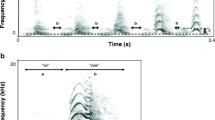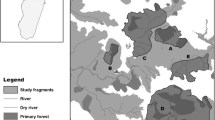Summary
We investigated the calling energetics of Hyla microcephala, a neotropical treefrog with an unusually complex vocal repertoire. Males respond to the calls of other individuals by adding secondary click notes to their calls, thereby increasing the total number of notes given per minute. Rates of oxygen consumption of males calling in metabolic chambers were 0.41–2.80 ml O2/(g·h), corresponding to calling rates of 205–6330 notes/h. Note rate explained 95% of the variance in meta-bolic rate; the effect of variation in body size and temperature was small. Data from playback experiments with males in the field showed that note rate increased as as the number of notes in a stimulus call increased, and this resulted in substantial increases in the cost of calling. Average metabolic rates for males in the field were about 1.7 ml O2/(g·h), for a net cost of calling of about 20 J/h for an average-size male. However, estimated metabolic rates varied by more than 300% and were strongly influenced by the proximity and calling activity of other males in the chorus. Male H. microcephala appear to conserve energy by reducing calling rates when only a few males are active and increasing calling efforts only when vocal competition among males is intense.
Similar content being viewed by others
References
Arak A (1983) Male-male competition and mate choice in anuran amphibians. In: Bateson P (ed) Mate choice. Cambridge University Press, New York, pp 181–210
Bucher TL, Ryan MJ, Bartholomew GA (1982) Oxygen consumption during resting, calling, and nest building in the frog Physalaemus pustulosus. Physiol Zool 55:10–22
Davies NB, Lundberg A (1984) Food distribution and a variable mating system in the dunnock (Prunella modularis). J Anim Ecol 53:895–912
Duellman WE (1970) The hylid frogs of Middle America. University of Kansas Museum of Natural History, Lawrence
Fellers GM (1979) Mate selection in the gray treefrog, Hylaversicolor. Copeia 1979:286–290
Fouquette MJ, Jr (1960) Isolating mechanisms in three sympatric treefrogs in the Canal Zone. Evolution 14:484–497
Garson PJ, Hunter ML Jr (1979) Effects of temperature and time of year on the singing behaviour of wrens Troglodytes troglodytes and great tits Parus major. Ibis 121:481–487
Gerhardt HC (1975) Sound pressure levels and sound radiation patterns of the vocalizations of some North American frogs and toads. J Comp Physiol 102:1–12
Gerhardt HC (1988) Acoustic properties used in call recognition by frogs and toads. In: Fritzsch B, Ryan MJ, Wilczynski W, Hetherington TE, Walkowiak W (eds) The evolution of the amphibian auditory system. John Wiley and Sons, New York, pp 455–483
Gerhardt HC, Daniel RE, Perrill SA, Schramm S (1987) Mating behaviour and male mating success in the green treefrog. Anim Behav 35:1490–1503
Given MF (1987) Vocalizations and acoustic interactions of the carpenter frog, Rana virgatipes. Herpetologica 43:467–481
Given MF (1988) Growth rate and the cost of calling activity in male carpenter frogs, Rana virgatipes. Behav Ecol Sociobiol 22:153–160
Godwin GJ, Roble SM (1983) Mating success in male treefrogs, Hyla chrysoscelis (Anura: Hylidae). Herpetologica 39:141–146
Gottlander K (1987) Variation in the song rate of the male pied flycatcher Ficedula hypoleuca: causes and consequences. Anim Behav 35:1037–1043
Greer BJ, Wells KD (1980) Territorial and reproductive behavior of the tropical American frog Centrolenella fleischmanni. Herpetologica 36:318–326
Hedges SB (1986) An electrophoretic analysis of Holarctic hylid frog evolution. Syst Zool 35:1–21
Higgens RM (1979) Temperature-related variation in the duration of morning song of the song thrush, Turdus ericetorium. Ibs 121:333–335
Jenssen TA (1972) Seasonal organ weights of the green frog, Rana clamitans (Anura, Ranidae), under natural conditions. Trans Ill State Acad Sci 65:15–24
Kluge AG (1981) The life history, social organization, and parental behavior of Hyla rosenbergi Boulenger, a nest-building gladiator frog. Misc Publ Mus Zool Univ Michigan 160:1–170
Klump GM, Gerhardt HC (1987) Use of non-arbitrary acoustic criteria in mate choice by female gray tree frogs. Nature 326:286–288
Mac Nally RC (1981) On the reproductive energetics of chorusing males: energy depletion profiles, restoration and growth in two sympatric species of Ranidella (Anura). Oecologia 51:181–188
Marsh RL, Taigen TL (1987) Properties enhancing aerobic capacity of calling muscles in gray tree frogs Hyla versicolor. Am J Physiol 252:R786-R793
Martin WF (1972) Evolution of vocalization in the genus Bufo. In: W.F. Blair (ed) Evolution in the genus Bufo. University of Texas Press, Austin, pp 279–309
Pough FH (1983) Amphibians and reptiles as low-energy systems. In: Aspey WP, Lustick SI (eds) Behavioral energetics. Ohio State University Press, Columbus, pp 141–188
Prestwich KN, Brugger KE, Toppling M (1989) Energy and communication in three species of hylid frogs: power input, power output, and efficiency. J Exp Biol (in press)
Radesäter T, Jakobsson S, Andbjer N, Bylin A, Nyström K (1987) Song rate and pair formation in the willow warbler, Phylloscopus trochilus. Anim Behav 35:1645–1651
Rand AS, Ryan MJ (1981) The adaptive significance of a complex vocal repertoire in a neotropical frog. Z Tierpsychol 57:209–214
Reid ML (1987) Costliness and reliability in the singing vigour of Ipswich sparrows. Anim Behav 35:1735–1743
Ryan MJ (1983) Sexual selection and communication in a neotropical frog, Physalaemus pustulosus. Evolution 37:261–272
Ryan MJ (1985) The tungara frog. University of Chicago Press, Chicago
Ryan MJ (1988) Constraints and patterns in the evolution of anuran acoustic communication. In: Fritzsch B, Ryan MJ, Wilczynski W, Hetherington T, Walkowiak W (eds) The evolution of the amphibian auditory system. John Wiley and Sons, New York, pp 637–677
Ryan MJ, Bartholomew GA, Rand AS (1983) Energetics of reproduction in a neotropical frog, Physalaemus pustulosus. Ecology 64:1456–1462
Ryan MJ, Tuttle MD, Rand AS (1982) Bat predation and sexual advertisement in a neotropical frog. Am Nat 119:136–139
Schmidt RS (1965) Larynx control and call production in frogs. Copeia 1965:143–147
Schwartz JJ (1986) Male calling behavior and female choice in the neotropical treefrog Hyla microcephala. Ethology 73:116–127
Schwartz JJ (1987) The importance of spectral and temporal properties in species and call recognition in a neotropical treefrog with a complex vocal repertoire. Anim Behav 35:340–347
Schwartz JJ, Wells KD (1985) Intra-and interspecific vocal behavior of the neotropical treefrog Hyla microcephala. Copeia 1985:27–38
Seale DB (1987) Amphibia. In: Vernberg FJ, Pandian TJ (eds) Animal energetics. Academic Press, New York, vol. I, pp 467–551
Searcy WA (1979) Sexual selection and male body size in male red-winged blackbirds. Evolution 33:649–661
Sullivan BK (1983) Sexual selection in Woodhouse's toad (Bufo woodhousei): female choice. Anim Behav 31:1011–1017
Taigen TL, Wells KD (1985) Energetics of vocalization by an anuran amphibian (Hyla versicolor). J Comp Physiol B 155:163–170
Taigen TL, Wells KD, Marsh RL (1985) The enzymatic basis of high metabolic rates in calling frogs. Physiol Zool 58:719–726
Tuttle MD, Ryan MJ (1981) Bat predation and the evolution of frog vocalizations in the neotropics. Science 214:677–678
Vleck CM, Hoyt DF, Vleck D (1979) Metabolism of avian embryos: patterns in altricial and prococial birds. Physiol Zool 52:363–377
Wells KD (1978) Territoriality in the green frog (Rana clamitans): vocalizations and aggressive behaviour. Anim Behav 26:1051–1063
Wells KD (1988) The effect of social interactions on anuran vocal behavior. In: Fritzsch B, Ryan MJ, Wilczynski W, Hetherington TE, Walkowiak W (eds) The evolution of the amphibian auditory system. John Wiley and Sons, New York, pp 433–454
Wells KD, Taigen TL (1986) The effect of social interactions on calling energetics in the gray treefrog (Hyla versicolor). Behav Ecol Sociobiol 19:9–18
Wilhelm KH, Comtesse H, Phlumm W (1980) Zur Abhängigkeit des Gesangs von Nahrungsangebot beim Gelbbauchnektarvogel (Nectarina venusta). Z Tierpsychol 54:185–202
Woolbright LL (1985) Sexual dimorphism in body size of the subtropical frog, Eleutherodactylus coqui. Unpublished Ph.D. dissertation, State University of New York at Albany
Author information
Authors and Affiliations
Rights and permissions
About this article
Cite this article
Wells, K.D., Taigen, T.L. Calling energetics of a neotropical treefrog, Hyla microcephala . Behav Ecol Sociobiol 25, 13–22 (1989). https://doi.org/10.1007/BF00299706
Received:
Accepted:
Issue Date:
DOI: https://doi.org/10.1007/BF00299706




